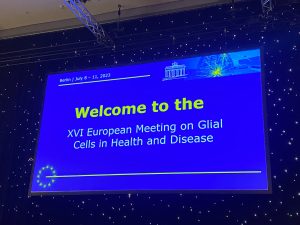Hello everyone,
I’m Samuela, a Master’s student in the University of Helsinki Neuroscience program expecting to graduate soon. Today I will bring you back with me to the European Glia Meeting I attended last July in Berlin supported by the HiLIFE Conference Grant!
Choose a conference and apply!
I simply love the brain, and I always have been fascinated by how imperceptible processes allow us to think and behave. Throughout my Master’s studies, I got passionate about glial cells, which are the “supporting cells” of the brain very different from the well-known neurons. These cells are microglia, the brain’s immune cells, astrocytes contributing to the blood-brain barrier, and oligodendrocytes wrapping neuronal axons to ensure fast communication.
Lately, research in my field greatly shifted to glial cells due to their involvement during development and disease etiology. Therefore, I decided to attend this internationally recognised conference hosting the best researchers working on glia and coming from all around the world.
The application process for the HiLife Conference grant is really straightforward and pushes you to think about why you want to attend that specific conference and the impact it may have on your future career. The process is fast and simple, so try to individuate the conference that aligns better with your interests and apply!
A conference helps you and your career goals in many ways!
I won’t lie, participating in long conferences is exhausting, but extremely rewarding! You get to know fellow students and researchers potentially establishing the ground for lifelong friendships and collaborations. Additionally, you get exposed to the most recent and exciting research on what passionates you.
I chose a conference with a very wide program, spanning from technical innovations for glial engineering to neutron-glia and glia-glia communication. I got to listen to recently published/unpublished data and gradually understood the logic behind experiments. Attending these talks gave me an overview of scientific thinking and the long process that leads from an idea to a discovery, exciting!
I chose to attend a voluntary Introductory course, prior to the start of the conference. It was a one-day course covering the basics of glial cell function in healthy and diseased brains both in the central and peripheral nervous systems. We also explored methods to study glia from stem cells to different animal models including Drosophila (common fruit fly).
The four-day program of the official conference was dense and included workshops on techniques used to investigate microglia and on scientific publishing. The lectures were of different types: plenary lectures by big names such as Freda Miller, Shane Liddelow, and Michelle Monje, and symposia featuring 4 speakers with a common focus (e.g., heterogeneity of microglia in brain stem cell niches).
I also got to listen to a symposium organized by my Master’s thesis supervisor and HiLIFE director Jari Koistinaho, focused on the study of neuroinflammation and neurodegeneration employing induced pluripotent stem cells. Helsinki and HiLIFE were greatly represented at the conference!

A highlight of conferences is certainly poster sessions. Posters are usually presented by young scientists (PhD and postdocs) and are a peerless opportunity to exercise your social and presentation skills!

I decided to be brave and present my own poster based on the research on microglia and Alzheimer’s disease conducted at the HiLIFE Neuroscience Center!
Initially, I was scared of not being able to answer questions and successfully deliver the main points of my research to the audience. But it was fun, engaging, and extremely rewarding. Don’t hesitate and challenge yourself!

Beyond the conference
Conferences are not only an educational opportunity, but also a way to visit new places and countries. The Glia Conference was held in Berlin, which I never visited before. Accompanied by students I met at the conference and also alone, I visited some of Berlin’s highlights!


The last night everyone I met was gone, and I enjoyed a solo dinner in a traditional German restaurant! These experiences make you certainly more independent.
Some advice for embarking on your conference adventure
Overall, I would highly recommend to participate in a conference. Here are some useful tips:
- HiLIFE Conference Grant most likely does not cover all your expenses (the max amount in the 2023 call was 300 euros). However, most conferences offer stipends for those students who present posters. I would suggest presenting a poster for additional funding and for enhancing your presentation skills.
- Plan in advance! I suggest you look for a conference you would like to attend as soon as possible since all costs rise with time. Conferences usually offer early-bird and student discounts with advantageous prices.
- Look for partnerships and agreements between conference organisers and airlines and hotels. Sometimes they might be more convenient than other options, but sometimes you will need to find cheaper solutions (like Airbnb, which I opted for my stay).
- Do some homework before the conference. It is important you arrive there prepared and organised, with a schedule of what you want to attend and who you want to meet, if possible. For instance, I took the opportunity to talk to some researchers from universities I’m applying to for the PhD.
Final remarks
Thanks, everyone for following my journey! I hope I have inspired you to join a conference you like.
If you are interested in the next European Glia Meeting, it will be held in Marseille in 2025 (it is a bi-annual meeting).
Feel free to contact me with any further questions you may have about the conference!

